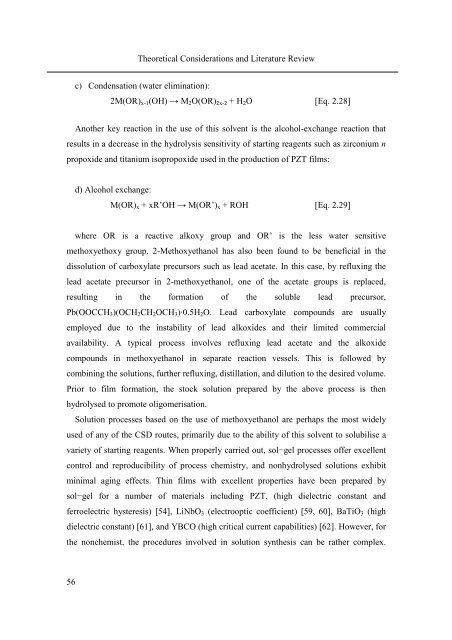PhD Thesis Arne Lüker final version V4 - Cranfield University
PhD Thesis Arne Lüker final version V4 - Cranfield University
PhD Thesis Arne Lüker final version V4 - Cranfield University
You also want an ePaper? Increase the reach of your titles
YUMPU automatically turns print PDFs into web optimized ePapers that Google loves.
56<br />
Theoretical Considerations and Literature Review<br />
c) Condensation (water elimination):<br />
2M(OR)x-1(OH) → M2O(OR)2x-2 + H2O [Eq. 2.28]<br />
Another key reaction in the use of this solvent is the alcohol-exchange reaction that<br />
results in a decrease in the hydrolysis sensitivity of starting reagents such as zirconium n<br />
propoxide and titanium isopropoxide used in the production of PZT films:<br />
d) Alcohol exchange:<br />
M(OR)x + xR’OH → M(OR’)x + ROH [Eq. 2.29]<br />
where OR is a reactive alkoxy group and OR’ is the less water sensitive<br />
methoxyethoxy group. 2-Methoxyethanol has also been found to be beneficial in the<br />
dissolution of carboxylate precursors such as lead acetate. In this case, by refluxing the<br />
lead acetate precursor in 2-methoxyethanol, one of the acetate groups is replaced,<br />
resulting in the formation of the soluble lead precursor,<br />
Pb(OOCCH3)(OCH2CH2OCH3)·0.5H2O. Lead carboxylate compounds are usually<br />
employed due to the instability of lead alkoxides and their limited commercial<br />
availability. A typical process involves refluxing lead acetate and the alkoxide<br />
compounds in methoxyethanol in separate reaction vessels. This is followed by<br />
combining the solutions, further refluxing, distillation, and dilution to the desired volume.<br />
Prior to film formation, the stock solution prepared by the above process is then<br />
hydrolysed to promote oligomerisation.<br />
Solution processes based on the use of methoxyethanol are perhaps the most widely<br />
used of any of the CSD routes, primarily due to the ability of this solvent to solubilise a<br />
variety of starting reagents. When properly carried out, sol−gel processes offer excellent<br />
control and reproducibility of process chemistry, and nonhydrolysed solutions exhibit<br />
minimal aging effects. Thin films with excellent properties have been prepared by<br />
sol−gel for a number of materials including PZT, (high dielectric constant and<br />
ferroelectric hysteresis) [54], LiNbO3 (electrooptic coefficient) [59, 60], BaTiO3 (high<br />
dielectric constant) [61], and YBCO (high critical current capabilities) [62]. However, for<br />
the nonchemist, the procedures involved in solution synthesis can be rather complex.

















